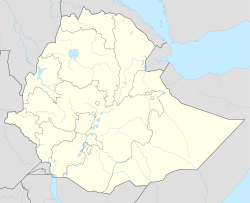Samre, Ethiopia
| Samre | |
|---|---|
| Location within Ethiopia | |
| Coordinates: 13°11′N 39°12′E / 13.183°N 39.200°E | |
| Country | Ethiopia |
| Region | Tigray |
| Zone | Debub Misraqawi (south-eastern) |
| Elevation | 1,855 m (6,086 ft) |
| Population (2005) | |
| • Total | 3,712 |
| Time zone | EAT (UTC+3) |
Samre is a town in northern Ethiopia. Located in the Debub Misraqawi (south-eastern) Zone of the Tigray Region, this town has a latitude and longitude of 13°11′N 39°12′E / 13.183°N 39.200°ECoordinates: 13°11′N 39°12′E / 13.183°N 39.200°E with an elevation of 1855 meters above sea level. It is one of two towns in Samre woreda.
The Royal Chronicle of Emperor Yohannes I mentions Samre as one of the settlements involved in the 1677 revolt of Fares and Zamaryam. The town is mentioned again in an inquiry conducted by Emperor Iyasu I in 1698, in which he proclaimed that tolls should no longer be collected there.
When Charles Beke left Ethiopia, his path took him through Samre (April 1843). He wrote that it was the residence of the governor of "Salowa", and the location of "the salt-market of Tigre, in direct correspondence with Sókota in Lasta". When Augustus B. Wylde passed through Samre in the late 1890s, the town had declined since the death of its resident lord, one Ras Hailu. The late Ras's palace, one of the largest structures Wylde had seen in Ethiopia, was reduced to ruins, and its market, which had been so busy to require daily sessions, now met once a week on Saturdays.
...
Wikipedia

